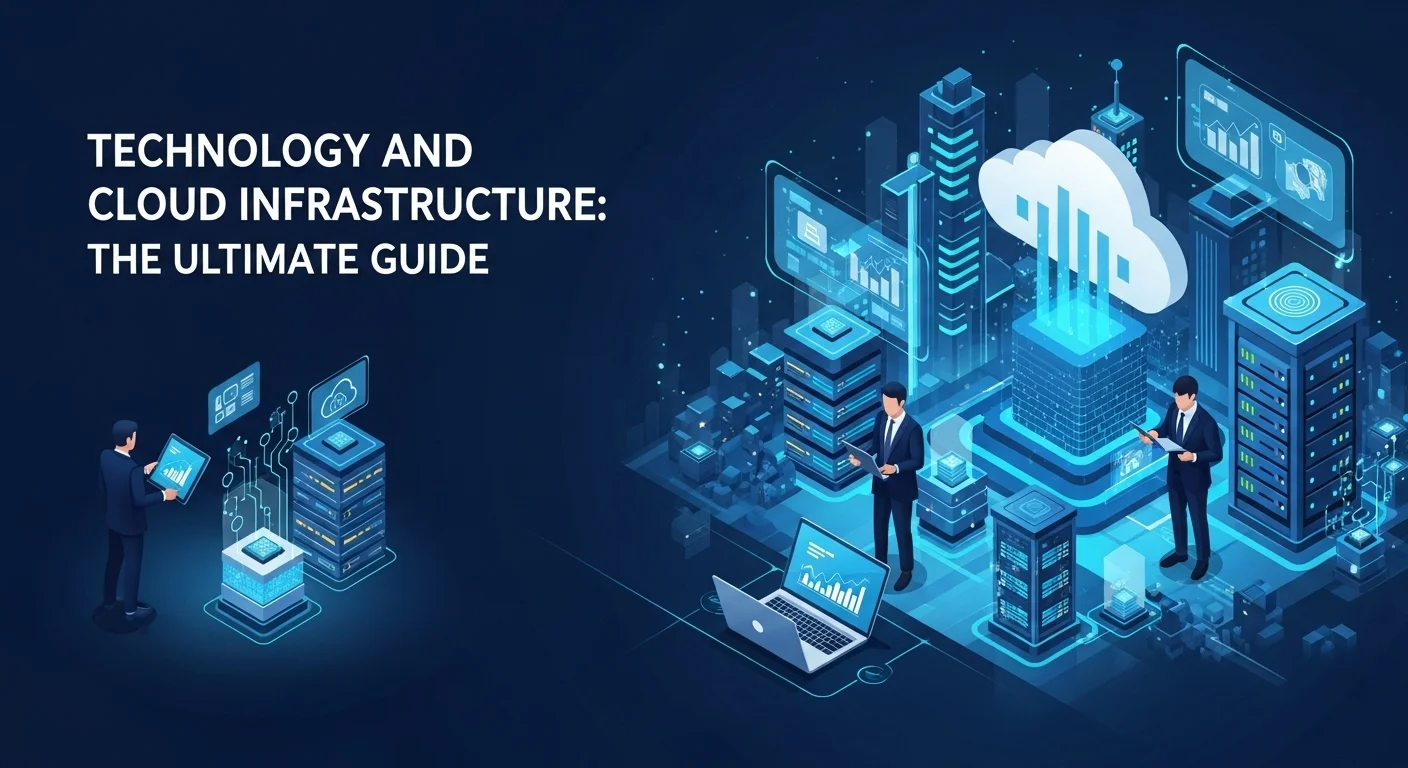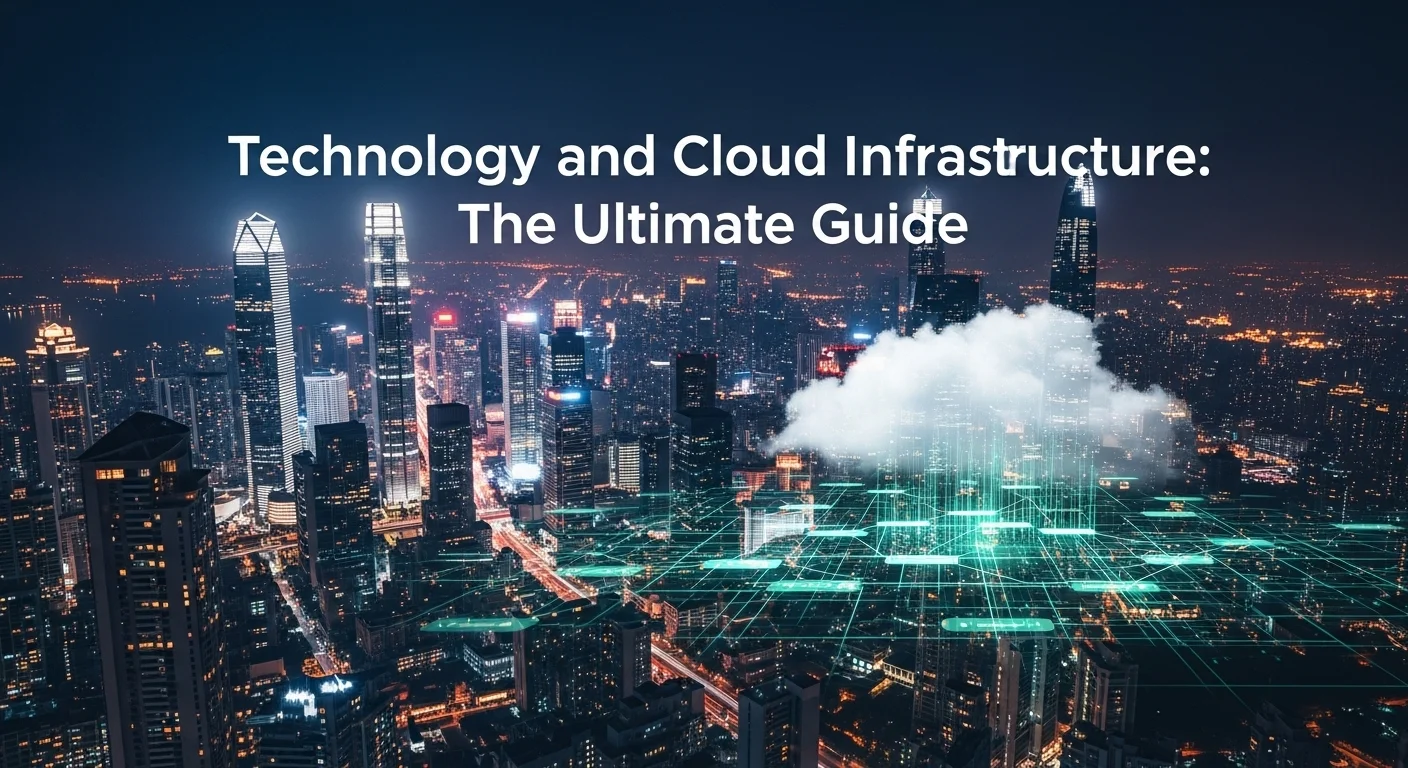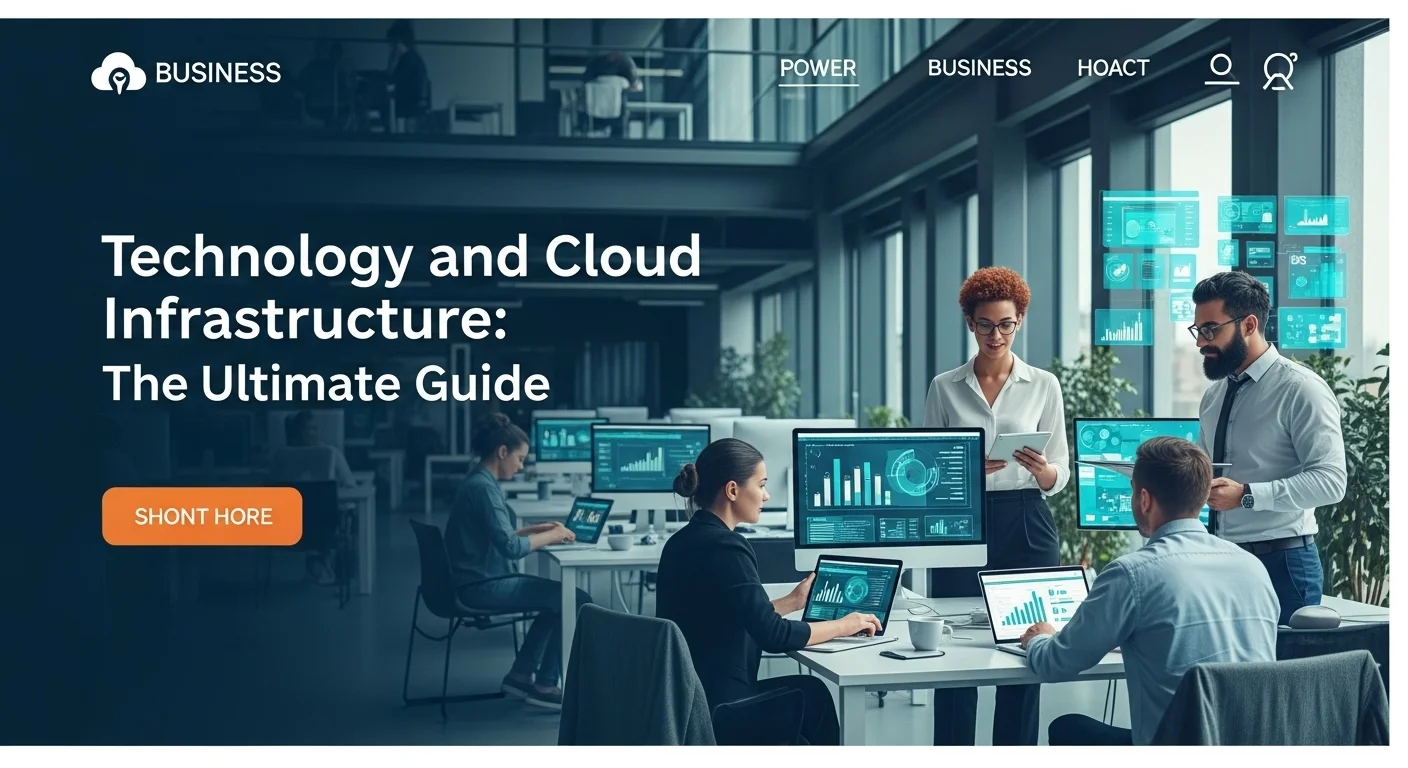Cloud Infrastructure Explained: A Practical Guide for Today's Tech World

Executive Summary
In my 15+ years as a cloud architect, I've seen businesses transform by truly understanding their tech backbone. This guide isn't just about definitions; it's about making sense of cloud infrastructure. We'll walk through the essentials—compute, storage, and networking—and demystify models like public, private, and hybrid clouds. I'll share insights on using Infrastructure as a Service (IaaS), boosting efficiency, and building a solid data framework. This is for anyone, from tech pros to business leaders, who wants to stop just *using* the cloud and start *leveraging* it for real growth.
Table of Contents
Table of Contents
What is Cloud Infrastructure and why is it important in Technology?
You hear 'the cloud' everywhere, but what does that actually mean under the hood? Let's peel back the layers. In simple terms, cloud infrastructure is all the hardware and software needed to make cloud computing possible. Think of it like this: instead of building and managing your own data center with servers, storage, and networking gear, you rent access to a massive, professionally managed one over the internet. These are run by providers you've probably heard of, like Amazon Web Services (AWS), Microsoft Azure, or Google Cloud. From my experience, the biggest shift for businesses is moving from a huge upfront investment in hardware (a capital expense) to a flexible, pay-as-you-go model (an operational expense). This alone has leveled the playing field, freeing up resources and cash for innovation.
The importance of cloud infrastructure today is massive; it's the invisible backbone of our digital lives. It powers everything from the apps on your phone to complex systems running artificial intelligence (AI) and the Internet of Things (IoT). The real magic lies in its elasticity. Imagine your website traffic suddenly triples. In the old days, your servers would crash. With the cloud, your infrastructure can automatically scale up to handle the load and then scale back down when things quiet down, saving you money. This agility is a game-changer. I've seen startups go head-to-head with industry giants because they could deploy powerful applications without the massive initial cost. Furthermore, a well-designed cloud based infrastructure offers incredible reliability. Providers have data centers all over the world, so if one has an issue, your services can keep running from another location, ensuring your customers always have access.
Core Components of Cloud Infrastructure
To really get it, you need to know the main ingredients. These are the building blocks that every cloud provider uses:
- Compute: This is the engine—the raw processing power that runs your applications. In the cloud, this comes from powerful servers that are sliced up into virtual machines (VMs) using special software. This is what allows multiple customers to share the same physical hardware securely and efficiently. We're now even seeing more advanced options like containers and serverless computing, which make things even more streamlined.
- Storage: This is where your data lives. Cloud storage is incredibly versatile. You have object storage for unstructured files like photos and videos, block storage that acts like a traditional hard drive for your VMs, and file storage for shared network drives. A solid cloud data infrastructure is the foundation for managing the enormous amount of data modern businesses produce.
- Networking: This is the plumbing that connects everything. It includes the physical switches and routers, but also virtual networks that let you create your own private, isolated corner of the cloud. This is critical for security and organizing your resources.
- Software and Management Tools: This is the control panel for the entire system. It's the software that lets you click a button to launch a new server, configure your network, and monitor performance. These tools are what make the cloud's power accessible to everyone, not just network engineers.
When to Go Private: The Role of Private Cloud Infrastructure
While public clouds like AWS are fantastic, some organizations need more control, often for security or regulatory reasons. This is where a private cloud infrastructure comes in. A private cloud is a cloud environment dedicated to a single organization. It can be in your own data center or hosted by a third party, but the key is that you're not sharing hardware with anyone else. I've worked with clients in finance and healthcare where this is a non-negotiable requirement to comply with regulations like HIPAA. It gives them the highest level of security and customization. While setting it up can be more involved, the peace of mind is worth it for certain workloads. Many companies I advise now use a hybrid approach, mixing the security of a private cloud for sensitive data with the cost-effectiveness and scale of a public cloud for other applications. This 'best of both worlds' strategy lets you choose the right cloud infrastructure solutions for the right job, creating a powerful and flexible IT environment.
Ultimately, understanding cloud infrastructure isn't just for the tech team; it's a strategic business conversation. By moving to a flexible cloud based infrastructure, companies can focus on what they do best instead of just keeping the lights on. It's about building resilient products, managing a sophisticated cloud data infrastructure, and being able to pivot quickly in a fast-changing market.

Complete guide to Cloud Infrastructure in Technology and Business Solutions
Getting your hands dirty with cloud technology means going beyond the basics. It requires a practical understanding of the available cloud infrastructure solutions and how to stitch them together to solve real business problems. This guide is my attempt to share what I've learned about the technical methods and business strategies that work. The first big decision is choosing your service model, which really defines how much you manage versus how much the provider manages for you.
- Infrastructure as a Service (IaaS): This is the foundation. You get the raw building blocks—servers, storage, and networking—and you're in charge of everything on top, like the operating system and applications. I see companies choose IaaS when they need maximum control or are moving existing applications to the cloud. Think of providers like AWS (with its EC2 and S3 services), Microsoft Azure, and Google Cloud. This is the bedrock of any cloud based infrastructure.
- Platform as a Service (PaaS): This model adds another layer. The provider manages the underlying infrastructure and operating systems, giving your developers a platform to build and run applications. I love PaaS because it lets developers focus purely on coding, which speeds everything up. Heroku and Google App Engine are classic examples.
- Software as a Service (SaaS): This is the most familiar model. You're using a complete application delivered over the internet, like Microsoft 365 or Salesforce. You don't manage anything; you just use the software. It offers the ultimate convenience.
Comparing Major Cloud Infrastructure Solutions: AWS vs. Azure vs. Google Cloud
Choosing a provider is a huge commitment. In my experience, it often comes down to these three giants:
Amazon Web Services (AWS) is the market leader for a reason. I think of it as the Swiss Army knife of the cloud—it has a tool for almost everything imaginable. Its maturity and massive partner ecosystem make it a safe bet for many. For anyone building a serious cloud data infrastructure, the depth of its services, like Redshift for data warehousing, is hard to beat.
Microsoft Azure is the go-to for enterprises that are already deep in the Microsoft world. Its killer feature is the seamless integration with on-premises Windows systems, making it a natural fit for a hybrid cloud strategy. For businesses wanting a private cloud infrastructure, Azure Stack lets you run Azure services in your own data center, which is a powerful proposition.
Google Cloud Platform (GCP) has made its name in containers, big data, and machine learning. Having created Kubernetes, the standard for container management, GCP has a real edge in modern, cloud-native development. I always recommend GCP to clients whose business revolves around data analytics and AI; tools like BigQuery are just phenomenal.
Business Techniques for Cloud Adoption and Management
Moving to the cloud is a business project, not just a tech one. Your migration strategy is everything. I generally see three main paths:
- Rehosting (Lift and Shift): The quickest way. You move applications as-is. It gets you to the cloud fast, but you won't get all the benefits.
- Replatforming (Lift and Reshape): A middle ground. You make a few tweaks to your application to take advantage of cloud features, like switching to a managed database.
- Refactoring/Rearchitecting: The most intensive path, but with the biggest payoff. You redesign your application to be fully cloud-native. This unlocks amazing scalability and resilience.
Once you're there, managing costs is crucial. I've seen budgets spiral out of control without a proper plan. This is where FinOps (Cloud Financial Operations) becomes your best friend. It's a cultural shift to make everyone, from developers to finance, responsible for cloud spending. It's about constantly monitoring costs, right-sizing services, and building a cost-aware culture.
Finally, a strong governance framework is essential. You need clear rules for who can do what, how resources should be tagged for cost tracking, and how you'll enforce security policies. This is especially true when you're managing a hybrid setup with a private cloud infrastructure alongside public cloud services.
Architecting a Resilient Cloud Data Infrastructure
Today, data is everything. A well-architected cloud data infrastructure can be a huge competitive advantage. From what I've built over the years, a successful architecture usually has these layers:
- Data Ingestion: This is how you get data into your system, from all your different sources. This can be done in batches or in a continuous real-time stream.
- Data Storage: This is where the raw data lands. A 'data lake,' often built on affordable object storage like Amazon S3, is a popular choice for holding vast amounts of data in its original format.
- Data Processing: Here's where the raw data is cleaned, transformed, and prepared for analysis. This is where the heavy lifting happens.
- Data Serving: This final layer delivers the processed data to users or applications for analysis. This is often a cloud data warehouse, like Google BigQuery or Snowflake, that's built for lightning-fast queries.
Building this isn't trivial, but the payoff in business intelligence and AI-powered insights is immense. For any organization, understanding cloud infrastructure is the first step. Mastering its application is what truly leads to success.

Tips and strategies for Cloud Infrastructure to improve your Technology experience
Getting onto the cloud is just the beginning. To truly get the most out of it, you need to be constantly optimizing, securing, and exploring what's possible. Here are some of the most important tips and strategies I share with my clients to improve their experience with cloud infrastructure solutions.
Best Practices for Cloud Security and Compliance
I can't stress this enough: security in the cloud is a partnership. Your provider secures the cloud, but you are responsible for security *in* the cloud. This is non-negotiable.
- Adopt a 'Zero Trust' Mindset: The motto is 'never trust, always verify.' Authenticate and authorize every single request, even if it's coming from inside your network. Use multi-factor authentication (MFA) everywhere and give users and services the absolute minimum permissions they need to do their job.
- Encrypt Everything: Your data should be encrypted both when it's sitting in storage (at rest) and when it's moving across the network (in transit). All the major cloud providers give you the tools to do this easily. It's a fundamental step for protecting any sensitive information in your cloud data infrastructure.
- Lock Down Your Network: Use virtual private clouds (VPCs) to create isolated network sandboxes for your applications. Use security groups and network access control lists (NACLs) as your virtual firewalls to strictly control what traffic can get in and out.
- Automate Compliance Checks: Use tools like AWS Config or Azure Policy to keep an eye on your setup 24/7. They can automatically check if your environment follows your internal rules and external regulations (like GDPR or HIPAA) and can even fix issues for you. This is a lifesaver, especially if you're managing a private cloud infrastructure.
Strategies for Cost Optimization (FinOps)
The cloud's pay-as-you-go model is a double-edged sword. It's flexible, but costs can skyrocket if you're not paying attention. Think of FinOps as good financial hygiene for your cloud account.
- Right-Size and Shut Down: I often find that teams over-provision resources 'just in case.' Constantly check your utilization and downsize oversized servers. Also, be ruthless about finding and turning off 'zombie' resources that are running for no reason—they're a huge source of wasted money.
- Commit and Save: If you know you'll be using a certain amount of computing power for the next year or three, use Reserved Instances or Savings Plans. By committing, you can get massive discounts—I've seen savings of over 70%.
- Use Spot Instances for Non-Critical Work: For jobs that can be interrupted, like batch processing or testing, use spot instances. This is spare capacity that providers sell at a huge discount. The savings can be incredible if your workload is fault-tolerant.
- Tag Everything: A consistent tagging policy is the key to understanding your bill. Tag every resource with its owner, project, or department. This lets you see exactly where the money is going and makes different teams accountable for their spending.
Enhancing Performance and Resilience
A fast, reliable service is crucial for keeping users happy and your business running. A resilient cloud based infrastructure is your insurance policy.
- Use Auto-Scaling and Load Balancing: Set up auto-scaling to automatically add or remove servers based on traffic. This ensures you can handle surprise spikes without paying for idle machines. A load balancer will then distribute the traffic evenly, preventing any single server from getting overloaded.
- Go Multi-AZ and Multi-Region: For high availability, spread your application across multiple Availability Zones (AZs), which are separate data centers in the same region. For true disaster recovery, design your architecture to run across multiple geographic regions.
- Use a Content Delivery Network (CDN): A CDN caches your content in locations all over the world, closer to your users. This dramatically speeds up your website's load times and takes pressure off your servers.
- Monitor Everything: You can't fix what you can't see. Use monitoring tools like Amazon CloudWatch or third-party platforms like Datadog to get a deep view into your application's health. This helps you spot and fix problems before they affect your users.
Embracing Advanced Cloud Infrastructure Solutions
To really get ahead, you should start exploring the more advanced tools that the cloud offers.
- Containers and Kubernetes: These have become the gold standard for modern applications. They make your apps portable, scalable, and efficient in ways that traditional virtual machines can't match.
- Serverless Computing: For certain types of applications, serverless platforms like AWS Lambda are a revelation. You pay only for the exact moment your code is running, and you never have to think about managing a server again. It's the ultimate in cost efficiency.
- Infrastructure as Code (IaC): Using tools like Terraform or AWS CloudFormation, you can define your entire infrastructure in code. This automates everything, eliminates manual errors, and makes your setup repeatable and version-controlled. For more on these principles, I always point people to the AWS Well-Architected Framework; it's an invaluable resource.
By making these strategies part of your daily operations, you can move from just using the cloud to truly mastering it. A mature cloud strategy, built on a deep understanding of cloud infrastructure, is what will empower you to innovate faster and deliver real value.
Expert Reviews & Testimonials
Sarah Johnson, Business Owner ⭐⭐⭐⭐
As a small business owner, I found this guide really helpful for understanding the basics of cloud infrastructure. I wish there were a few more case studies for non-tech businesses, but it gave me the confidence to talk to IT vendors.
Mike Chen, IT Consultant ⭐⭐⭐⭐⭐
Solid overview of cloud infrastructure. As an IT consultant, I appreciated the clear comparison between AWS, Azure, and GCP. The section on FinOps was particularly relevant to my clients' needs.
Emma Davis, Tech Expert ⭐⭐⭐⭐⭐
An outstanding and thorough article on cloud infrastructure. I'm specializing in cloud architecture, and this piece connected a lot of dots for me. The explanations of IaC and serverless were crystal clear. Highly recommend!



